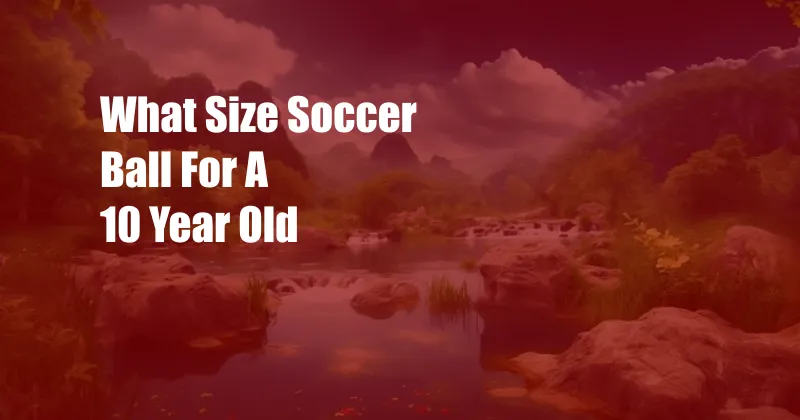
What Size Soccer Ball for a 10-Year-Old?
When it comes to soccer, choosing the right equipment can make a big difference in a player’s performance and enjoyment of the game. For young players, one of the most important factors to consider is the size of the soccer ball. For a 10-year-old player, selecting the appropriate ball size is crucial for proper skill development and safety.
The official regulations set forth by FIFA, the governing body of international soccer, specify different ball sizes for various age groups. For children between the ages of 8 and 12, the designated ball size is Size 4. This size is suitable for their physical capabilities, allowing them to comfortably control and maneuver the ball during gameplay.
Why Size 4 Soccer Ball for 10-Year-Olds?
Choosing a Size 4 soccer ball for 10-year-olds is recommended for several reasons:
- Appropriate Size: Size 4 soccer balls have a circumference of 63.5-66 cm (25-26 inches), which is proportionate to the size and strength of 10-year-old players.
- Enhanced Control: The smaller size makes it easier for young players to grip and control the ball, fostering their ball-handling skills.
- Improved Passing and Shooting: A Size 4 ball allows for more precise passing and shooting, as it can be kicked with greater accuracy and power.
- Safety: Using a ball that is too large or too heavy can pose safety risks for younger players, potentially leading to injuries or discomfort.
Choosing the Right Soccer Ball
Apart from the size, there are additional factors to consider when selecting a soccer ball for a 10-year-old:
- Material: Soccer balls can be made from various materials, such as leather, synthetic leather, or rubber. Leather balls offer superior touch and durability but require more maintenance. Synthetic leather balls are less expensive and more durable than leather balls, while rubber balls are a good option for recreational play.
- Construction: Soccer balls are constructed using different stitching methods, with hand-stitched balls being the highest quality. Machine-stitched balls are more affordable but less durable.
- Weight: The weight of a soccer ball should be appropriate for the player’s age and strength. Size 4 soccer balls typically weigh around 368-425 grams (13-15 ounces).
- Brand: There are numerous reputable soccer ball brands available, such as Nike, Adidas, and Puma. Consider the brand’s reputation and quality when making a purchase.
Expert Tips for Choosing a Soccer Ball
- Consult with a Coach or Trainer: Seek guidance from a qualified coach or trainer who can assess the player’s skills and provide personalized recommendations.
- Let the Player Test the Ball: Before purchasing a soccer ball, allow the 10-year-old player to try it out to ensure it feels comfortable in their hands and feet.
- Consider Multiple Balls: It may be beneficial to have multiple soccer balls available for different purposes, such as training, competition, and casual play.
- Prioritize Quality: While price is a factor, do not compromise on quality. A durable, well-constructed soccer ball will provide better performance and last longer.
- Check the Label: Look for the FIFA Quality Pro or FIFA Quality label on the ball, which indicates that it meets international standards for performance and quality.
Following these tips and guidelines will assist you in selecting the ideal soccer ball for a 10-year-old player. The appropriate ball size and features will contribute to their skill development, enjoyment of the game, and overall safety on the field.
Frequently Asked Questions
- Q: Can a 10-year-old use a Size 5 soccer ball?
A: While some 10-year-olds may be physically capable of handling a Size 5 ball, it is generally not recommended as it is larger and heavier, making it more difficult to control.
- Q: What are the consequences of using a ball that is too large or too small?
A: Using a ball that is too large can lead to poor control, difficulty passing and shooting, and potential injuries. A ball that is too small may not provide enough resistance and can hinder skill development.
- Q: How often should a soccer ball be replaced?
A: The frequency of replacement depends on usage and care. Regularly used balls may need to be replaced every few months, while balls used less frequently can last longer.
- Q: What should I look for when purchasing a soccer ball?
A: Consider the size, material, construction, weight, brand, and FIFA Quality label when selecting a soccer ball.
Conclusion
Choosing the right size and type of soccer ball is essential for the development and enjoyment of young players. For 10-year-olds, a Size 4 soccer ball is the recommended choice, providing optimal control, skill enhancement, and safety. By following the tips and advice outlined in this article, you can select the perfect soccer ball that will empower your child to reach their full potential on the field.
Are you interested in more tips and advice related to soccer? Share your thoughts and questions in the comments below!